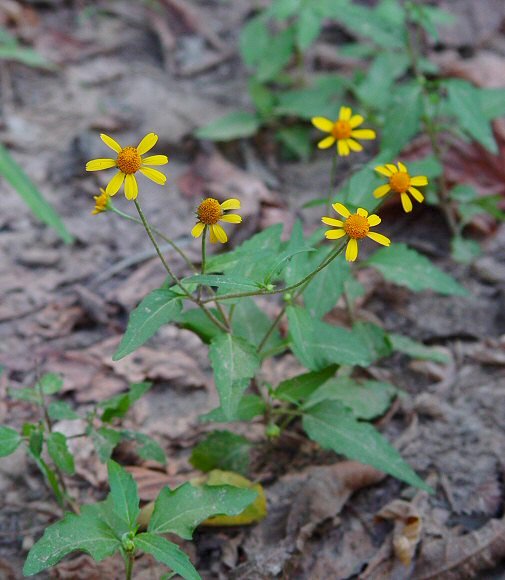Acmella repens (Walter) Rich.
Oppositeleaf Spotflower

Native
CC = 8
CW = -3
MOC = 8
© DETenaglia
Acmella repens (Walter) Rich.Oppositeleaf Spotflower | |
 |
Native CC = 8 CW = -3 MOC = 8 |
© DETenaglia |
|
Family - Asteraceae/Heliantheae Habit - Perennial forb with fibrous roots, sometimes rhizomatous. Stems - Spreading with ascending tips and branches, to 1 m, few- to several-branched, often rooting at the lower nodes, finely ridged or grooved, glabrous or pubescent with soft, curved hairs.
Leaves - Opposite, or the uppermost few alternate, petiolate. Leaf blades 1-8 cm long, narrowly lanceolate to broadly ovate, bluntly or more commonly sharply pointed, the margins finely to coarsely and bluntly to sharply toothed, the surfaces glabrous or sparsely pubescent along the veins with soft, curved hairs.
Inflorescence - Solitary heads at branch tips, on long, bractless, hairy stalks. Heads - Radiate, with conical receptacle elongating with maturity. Involucre 4-6 mm long, the bracts in 2 similar series. Involucral bracts 6-16, ascending, lanceolate, sharply pointed, green, with slightly irregular margins, the outer surface glabrous or sparsely hairy, with usually 3 fine nerves. Chaffy bracts subtending the ray and disc florets, these folded longitudinally and more or less wrapped around the florets.
Florets - Ray florets 5-15, pistillate, the corolla 3-9 mm long, relatively broad, yellow to orangish yellow, sparsely hairy toward the base. Disc florets numerous, perfect, the corolla 1.5-3.0 mm long, yellow, glabrous. Pappus of the ray and disc florets absent or the disc florets rarely with 1 or 2 short, slender awns. Fruits - Achenes 1.0-2.5 mm long, narrowly oblong-obovate, flattened (those of the ray florets somewhat 3-angled), usually irregularly warty, the surface otherwise glabrous, dark brown to black, the margins and warts straw-colored to yellowish brown. Flowering - July - October. Habitat - Low wet woods, borders of swamps and sloughs, ditches. Origin - Native to the U.S. and Central America. Lookalikes - Broadly, numerous other aster family species. Other info. - This little species can be found in a handful of southeastern Missouri counties. The plant is more common in states to the south and east, and in fact Missouri represents the far northern extent of its natural range. The species can be identified by its wet habitat, opposite leaves, pubescent stems, and conical yellow disks. The fruits usually have no pappus. Photographs taken at Arkansas Post Memorial, Gillett, AR., 8-31-06 and 9-7-06 (DETenaglia); also at Duck Creek Conservation Area, 7-31-2015 (SRTurner). |